belt SKODA SUPERB 2003 1.G / (B5/3U) User Guide
[x] Cancel search | Manufacturer: SKODA, Model Year: 2003, Model line: SUPERB, Model: SKODA SUPERB 2003 1.G / (B5/3U)Pages: 259
Page 82 of 259

Seats and Stowage81
Using the systemSafetyDriving TipsGeneral MaintenanceBreakdown assistanceTechnical Data
Caution
Please ensure that the heating elements of the rear window heater are not
damaged as a result of objects placed in this area.
Through-loading bag*
The through-loading bag enables you to conveniently
transport long objects (such as skis) without damaging the
interior of the car.
Loading
– Fold down the armrest of the rear seats to the front.
– Press the unlock button for the cover of the through-loading
bag in the interior of the car and swivel it down.
– Pull the bag out and unfold it.
– Open the boot lid/luggage compartment door.
– Press the unlock button for the cover of the through-loading bag ⇒fig. 65 and swivel it down.
– Push the objects into the through-loading bag from the boot ⇒ .
Securing
– Insert the belt ⇒fig. 66 into the middle seat belt buckle .
WARNING
No objects should be placed on the luggage compartment cover,
the vehicle occupants could be endangered if there is sudden
braking or the vehicle collides with something.
Fig. 65 Luggage
compartment: cover for
through-loading bag
Fig. 66 Attaching
through-loading bag to
middle seat belt buckle
of rear seats
AAAB
Page 83 of 259

Seats and Stowage
82
– Pull the seat belt tight in direction of arrow ⇒page 81,
fig. 66 .
Stowing
– Close the cover for the through-loading bag in the boot.
– Carefully fold the through-loading bag together (approx. 11 cm packet).
– Close the cover in the interior of the car.
– Move the armrest back into its original position.
Note
Never fold the though-loading bag together if it is moist.
The cool box in the armrest of rear seats*
Using the system
The contents of the cool box is cooled to a temperature of about
20 °C below the ambient temperature, but to a maximum of
approx.+ 5 °C.
Opening and Closing
– Pull the handle ⇒fig. 67 and pull the lid downwards.
– Open up the lid of the cool box upwards until it is heard to lock.
Switching on and off
– The cooling action of the cool box is switched on and off using switch ⇒fig. 67 . It is signalised by the lighting up of the
indicator light on the switch.
WARNING
After placing items into the through-loading bag, you must secure
the bag with the belt .
AC
AAFig. 67 Cool box
AA
Page 138 of 259
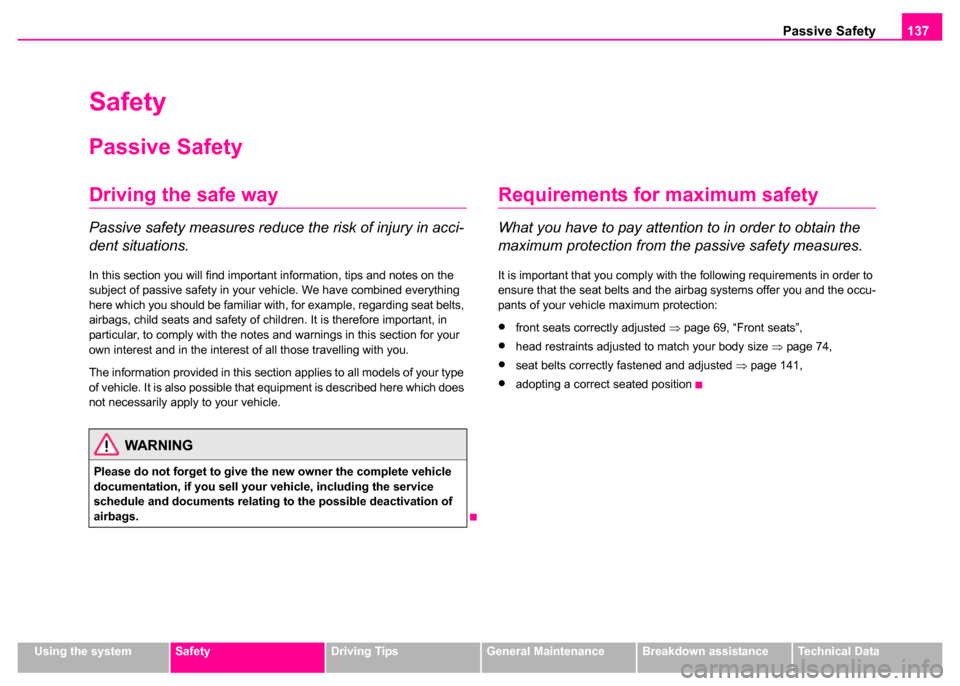
Passive Safety137
Using the systemSafetyDriving TipsGeneral MaintenanceBreakdown assistanceTechnical Data
Safety
Passive Safety
Driving the safe way
Passive safety measures reduce the risk of injury in acci-
dent situations.
In this section you will find important information, tips and notes on the
subject of passive safety in your vehicle. We have combined everything
here which you should be familiar with, for example, regarding seat belts,
airbags, child seats and safety of children. It is therefore important, in
particular, to comply with the notes and warnings in this section for your
own interest and in the interest of all those travelling with you.
The information provided in this section applies to all models of your type
of vehicle. It is also possible that equipment is described here which does
not necessarily apply to your vehicle.
Requirements for maximum safety
What you have to pay attention to in order to obtain the
maximum protection from the passive safety measures.
It is important that you comply with the following requirements in order to
ensure that the seat belts and the airbag systems offer you and the occu-
pants of your vehicle maximum protection:
•front seats correctly adjusted ⇒page 69, “Front seats”,
•head restraints adjusted to match your body size ⇒page 74,
•seat belts correctly fastened and adjusted ⇒page 141,
•adopting a correct seated position
WARNING
Please do not forget to give the new owner the complete vehicle
documentation, if you sell your vehicle, including the service
schedule and documents relating to the possible deactivation of
airbags.
Page 139 of 259
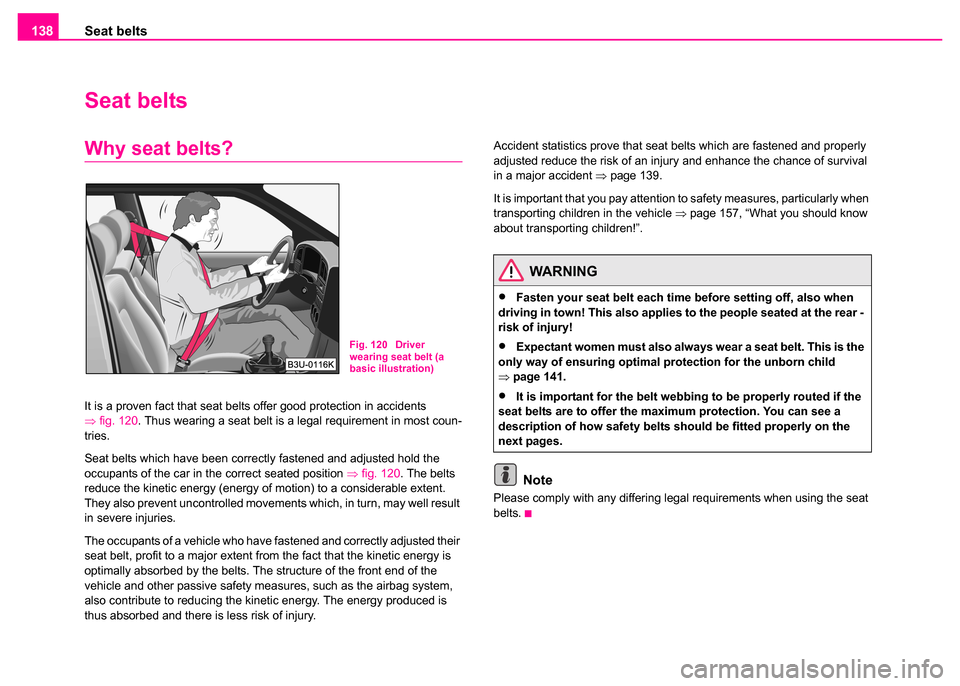
Seat belts
138
Seat belts
Why seat belts?
It is a proven fact that seat belts offer good protection in accidents
⇒ fig. 120 . Thus wearing a seat belt is a legal requirement in most coun-
tries.
Seat belts which have been correctly fastened and adjusted hold the
occupants of the car in the correct seated position ⇒ fig. 120. The belts
reduce the kinetic energy (energy of motion) to a considerable extent.
They also prevent uncontrolled movements which, in turn, may well result
in severe injuries.
The occupants of a vehicle who have fastened and correctly adjusted their
seat belt, profit to a major extent from the fact that the kinetic energy is
optimally absorbed by the belts. The structure of the front end of the
vehicle and other passive safety measures, such as the airbag system,
also contribute to reducing the kinetic energy. The energy produced is
thus absorbed and there is less risk of injury. Accident statistics prove that seat belts which are fastened and properly
adjusted reduce the risk of an injury and enhance the chance of survival
in a major accident
⇒page 139.
It is important that you pay attention to safety measures, particularly when
transporting children in the vehicle ⇒page 157, “What you should know
about transporting children!”.
Note
Please comply with any differing legal requirements when using the seat
belts.
Fig. 120 Driver
wearing seat belt (a
basic illustration)
WARNING
•Fasten your seat belt each time before setting off, also when
driving in town! This also applies to the people seated at the rear -
risk of injury!
•Expectant women must also always wear a seat belt. This is the
only way of ensuring optimal protection for the unborn child
⇒ page 141.
•It is important for the belt webbing to be properly routed if the
seat belts are to offer the maximum protection. You can see a
description of how safety belts should be fitted properly on the
next pages.
Page 140 of 259
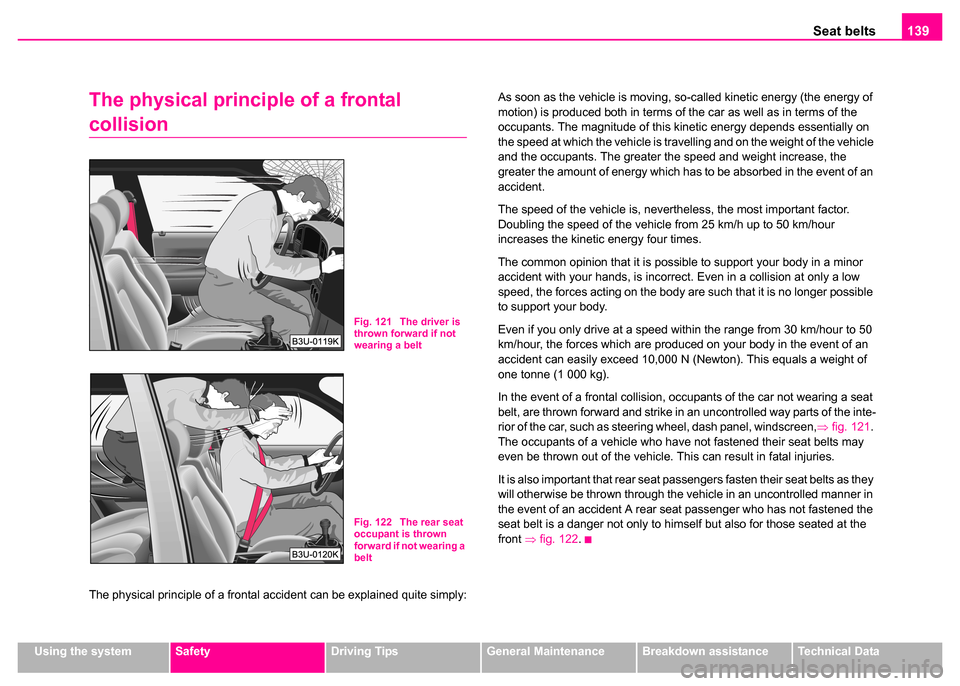
Seat belts139
Using the systemSafetyDriving TipsGeneral MaintenanceBreakdown assistanceTechnical Data
The physical principle of a frontal
collision
The physical principle of a frontal accident can be explained quite simply: As soon as the vehicle is moving, so-called kinetic energy (the energy of
motion) is produced both in terms of the car as well as in terms of the
occupants. The magnitude of this kinetic energy depends essentially on
the speed at which the vehicle is travelling and on the weight of the vehicle
and the occupants. The greater the speed and weight increase, the
greater the amount of energy which has to be absorbed in the event of an
accident.
The speed of the vehicle is, nevertheless, the most important factor.
Doubling the speed of the vehicle from 25 km/h up to 50 km/hour
increases the kinetic energy four times.
The common opinion that it is possible to support your body in a minor
accident with your hands, is incorrect. Even in a collision at only a low
speed, the forces acting on the body are such that it is no longer possible
to support your body.
Even if you only drive at a speed within the range from 30 km/hour to 50
km/hour, the forces which are produced on your body in the event of an
accident can easily exceed 10,000 N (Newton). This equals a weight of
one tonne (1 000 kg).
In the event of a frontal collision, occupants of the car not wearing a seat
belt, are thrown forward and strike in an uncontrolled way parts of the inte-
rior of the car, such as steering wheel, dash panel, windscreen,
⇒fig. 121 .
The occupants of a vehicle who have not fastened their seat belts may
even be thrown out of the vehicle. This can result in fatal injuries.
It is also important that rear seat passengers fasten their seat belts as they
will otherwise be thrown through the vehicle in an uncontrolled manner in
the event of an accident A rear seat passenger who has not fastened the
seat belt is a danger not only to himself but also for those seated at the
front ⇒fig. 122 .
Fig. 121 The driver is
thrown forward if not
wearing a belt
Fig. 122 The rear seat
occupant is thrown
forward if not wearing a
belt
Page 141 of 259
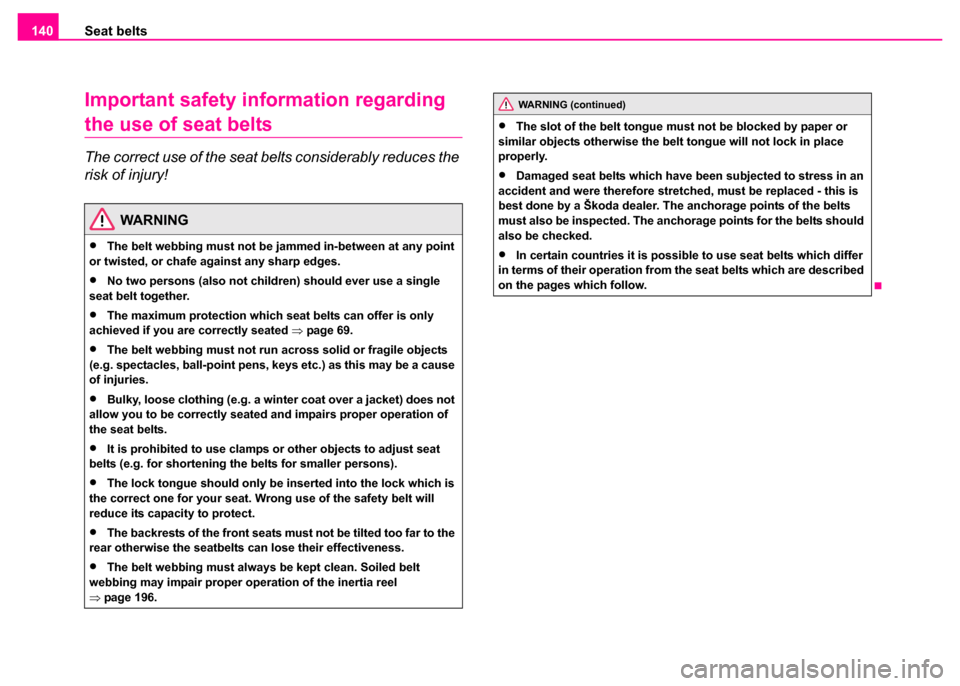
Seat belts
140
Important safety information regarding
the use of seat belts
The correct use of the seat belts considerably reduces the
risk of injury!
WARNING
•The belt webbing must not be jammed in-between at any point
or twisted, or chafe against any sharp edges.
•No two persons (also not children) should ever use a single
seat belt together.
•The maximum protection which seat belts can offer is only
achieved if you are correctly seated ⇒page 69.
•The belt webbing must not run across solid or fragile objects
(e.g. spectacles, ball-point pens, keys etc.) as this may be a cause
of injuries.
•Bulky, loose clothing (e.g. a winter coat over a jacket) does not
allow you to be correctly seated and impairs proper operation of
the seat belts.
•It is prohibited to use clamps or other objects to adjust seat
belts (e.g. for shortening the belts for smaller persons).
•The lock tongue should only be inserted into the lock which is
the correct one for your seat. Wrong use of the safety belt will
reduce its capacity to protect.
•The backrests of the front seats must not be tilted too far to the
rear otherwise the seatbelts can lose their effectiveness.
•The belt webbing must always be kept clean. Soiled belt
webbing may impair proper operation of the inertia reel
⇒ page 196.
WARNING (continued)
•The slot of the belt tongue must not be blocked by paper or
similar objects otherwise the belt tongue will not lock in place
properly.
•Damaged seat belts which have been subjected to stress in an
accident and were therefore stretched, must be replaced - this is
best done by a Škoda dealer. The anchorage points of the belts
must also be inspected. The anchorage points for the belts should
also be checked.
•In certain countries it is possible to use seat belts which differ
in terms of their operation from the seat belts which are described
on the pages which follow.
Page 142 of 259

Seat belts141
Using the systemSafetyDriving TipsGeneral MaintenanceBreakdown assistanceTechnical Data
How are seat belts correctly fastened?
Fastening a three-point seat belt
Fasten your seat belt before starting!
– Correctly adjust the front seat and the head restraint before
fastening your seat belt ⇒page 69, “Front seats”.
– Slowly pull the belt webbing at the tongue of the lock over your chest and pelvis ⇒.
– Insert the tongue of the lock into the seat belt buckle belonging to the seat until it is heard to lock in place.
– Pull on the belt to check that it has also reliably engaged in the lock.
Each three-point seat belt is equipped with an inertia reel. This inertia reel
offers you complete freedom of movement if the belt is unreeled slowly. If
the brakes are applied suddenly, the inertia reel will block. It also blocks
the belts when the car accelerates, when driving uphill and when
cornering.
Expectant mothers must also wear the seat belt ⇒.
Fig. 123 Routing of
webbing over the
shoulders and the lap
belt
Fig. 124 Routing of
belt webbing for an
expectant mother
WARNING
•The shoulder part of the seat belt must never run across your
neck but must run approximately over the middle of the shoulder
and fit snugly against the chest. The lap part of the belt must run
across the hip and must never be routed across the stomach. It
must always fit snugly ⇒fig. 123. Adjust the belt webbing as
required.
•The lap part of the belt should be positioned as low as possible
at the pelvis of an expectant mother in order to avoid exerting any
pressure on the lower abdomen.
•Always ensure that the webbing of the seat belts is properly
routed. Seat belts which are not correctly adjusted can themselves
cause injuries even in minor accidents.
Page 143 of 259
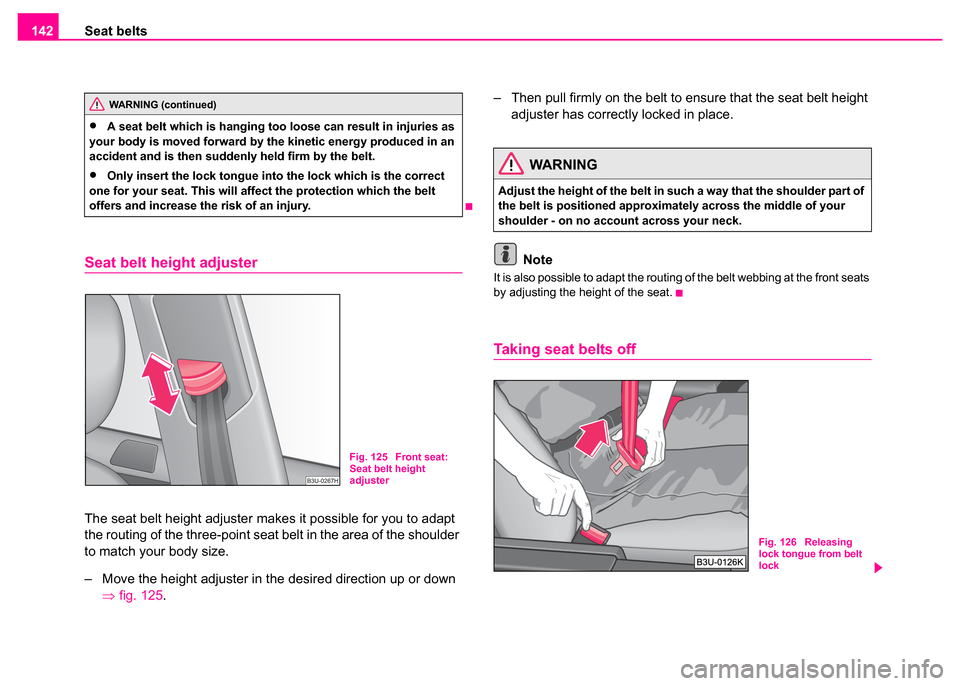
Seat belts
142
Seat belt height adjuster
The seat belt height adjuster makes it possible for you to adapt
the routing of the three-point seat belt in the area of the shoulder
to match your body size.
– Move the height adjuster in the desired direction up or down
⇒fig. 125 . – Then pull firmly on the belt to ensure that the seat belt height
adjuster has correctly locked in place.
Note
It is also possible to adapt the routing of the belt webbing at the front seats
by adjusting the height of the seat.
Taking seat belts off
WARNING (continued)
•A seat belt which is hanging too lo ose can result in injuries as
your body is moved forward by the kinetic energy produced in an
accident and is then suddenly held firm by the belt.
•Only insert the lock tongue into the lock which is the correct
one for your seat. This will affect the protection which the belt
offers and increase the risk of an injury.
Fig. 125 Front seat:
Seat belt height
adjuster
WARNING
Adjust the height of the belt in such a way that the shoulder part of
the belt is positioned approximately across the middle of your
shoulder - on no account across your neck.
Fig. 126 Releasing
lock tongue from belt
lock
Page 144 of 259
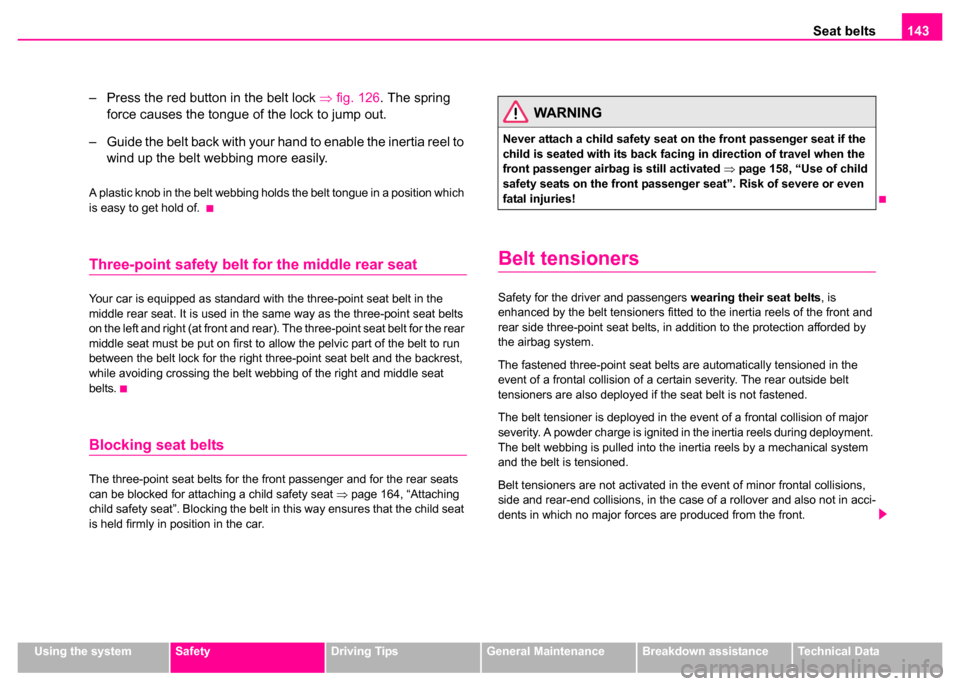
Seat belts143
Using the systemSafetyDriving TipsGeneral MaintenanceBreakdown assistanceTechnical Data
– Press the red button in the belt lock ⇒fig. 126. The spring
force causes the tongue of the lock to jump out.
– Guide the belt back with your hand to enable the inertia reel to wind up the belt webbing more easily.
A plastic knob in the belt webbing holds the belt tongue in a position which
is easy to get hold of.
Three-point safety belt for the middle rear seat
Your car is equipped as standard with the three-point seat belt in the
middle rear seat. It is used in the same way as the three-point seat belts
on the left and right (at front and rear). The three-point seat belt for the rear
middle seat must be put on first to allow the pelvic part of the belt to run
between the belt lock for the right three-point seat belt and the backrest,
while avoiding crossing the belt webbing of the right and middle seat
belts.
Blocking seat belts
The three-point seat belts for the front passenger and for the rear seats
can be blocked for attaching a child safety seat ⇒page 164, “Attaching
child safety seat”. Blocking the belt in this way ensures that the child seat
is held firmly in position in the car.
Belt tensioners
Safety for the driver and passengers wearing their seat belts, is
enhanced by the belt tensioners fitted to the inertia reels of the front and
rear side three-point seat belts, in addition to the protection afforded by
the airbag system.
The fastened three-point seat belts are automatically tensioned in the
event of a frontal collision of a certain severity. The rear outside belt
tensioners are also deployed if the seat belt is not fastened.
The belt tensioner is deployed in the event of a frontal collision of major
severity. A powder charge is ignited in the inertia reels during deployment.
The belt webbing is pulled into the inertia reels by a mechanical system
and the belt is tensioned.
Belt tensioners are not activated in the event of minor frontal collisions,
side and rear-end collisions, in the case of a rollover and also not in acci-
dents in which no major forces are produced from the front.
WARNING
Never attach a child safety seat on the front passenger seat if the
child is seated with its back facing in direction of travel when the
front passenger airbag is still activated ⇒page 158, “Use of child
safety seats on the front passenger seat”. Risk of severe or even
fatal injuries!
Page 145 of 259
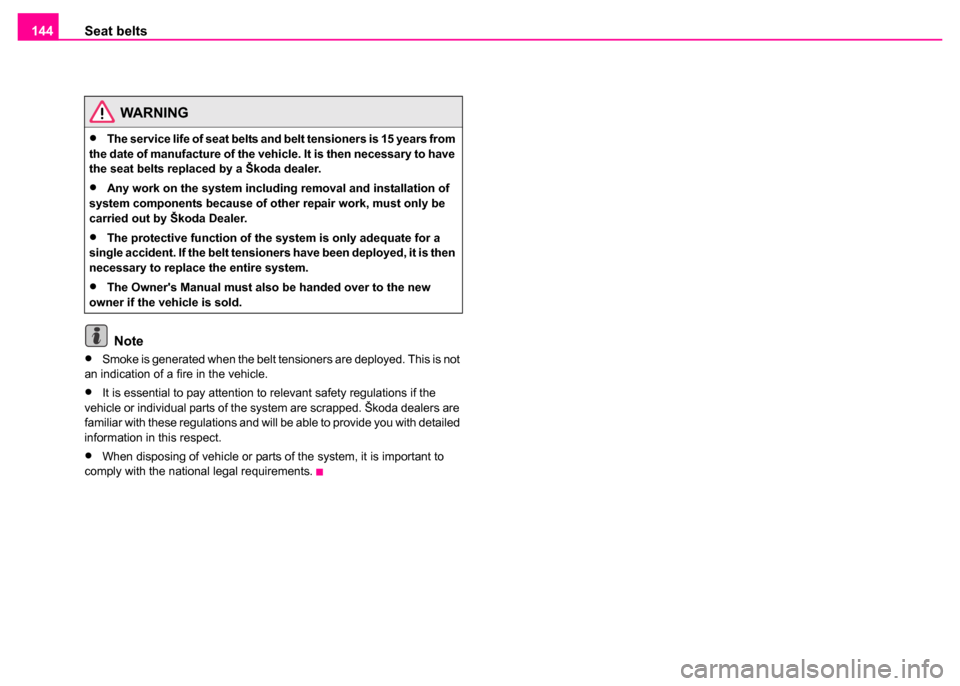
Seat belts
144
Note
•Smoke is generated when the belt tensioners are deployed. This is not
an indication of a fire in the vehicle.
•It is essential to pay attention to relevant safety regulations if the
vehicle or individual parts of the system are scrapped. Škoda dealers are
familiar with these regulations and will be able to provide you with detailed
information in this respect.
•When disposing of vehicle or parts of the system, it is important to
comply with the national legal requirements.
WARNING
•The service life of seat belts and belt tensioners is 15 years from
the date of manufacture of the vehicle. It is then necessary to have
the seat belts replaced by a Škoda dealer.
•Any work on the system including removal and installation of
system components because of other repair work, must only be
carried out by Škoda Dealer.
•The protective function of the system is only adequate for a
single accident. If the belt tensioners have been deployed, it is then
necessary to replace the entire system.
•The Owner's Manual must also be handed over to the new
owner if the vehicle is sold.